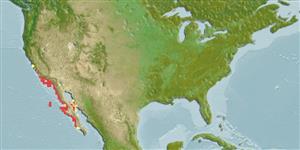>
Atheriniformes (Silversides) >
Atherinopsidae (Neotropical silversides) > Atherinopsinae
Etymology: Leuresthes: Greek, leyros, -a, -on = smooth + Greek, esthes = suit, something used to wrap (Ref. 45335).
More on author: Ayres.
Environment: milieu / climate zone / depth range / distribution range
Écologie
marin; profondeur 0 - 18 m (Ref. 2850). Subtropical; 37°N - 24°N, 123°W - 111°W
Eastern Pacific: Monterey Bay, USA to Baja California Sur, Mexico.
Length at first maturity / Taille / Poids / Âge
Maturity: Lm 11.9 range ? - ? cm
Max length : 19.0 cm TL mâle / non sexé; (Ref. 2850); âge max. reporté: 8 années (Ref. 1744)
Épines dorsales (Total): 4 - 8; Rayons mous dorsaux (Total): 8-10; Épines anales 1; Rayons mous anaux: 20 - 24; Vertèbres: 47 - 50. Branchiostegal rays: 6 (Ref. 36497).
Adults inhabit inshore waters, usually at or near surface along open coast and in bays (Ref. 36497). Oviparous, with planktonic primarily neustonic larvae (Ref. 36497). Eggs are deposited in the sand at night by the female parent (Ref. 58332) just below the high spring tide line (Ref. 36497). Minimum depth reported taken from Ref. 57178.
Demersal spawners. Spawn at night on sand beaches at high tides in the spring and summer. Eggs are buried in moist sand by the female parent (Ref. 58332) and hatch about 15 days later during the next series of high tides (Ref. 2850). Females spawn 4 to 8 times during a season (Ref. 4563).
Eschmeyer, W.N., E.S. Herald and H. Hammann, 1983. A field guide to Pacific coast fishes of North America. Boston (MA, USA): Houghton Mifflin Company. xii+336 p. (Ref. 2850)
Statut dans la liste rouge de l'IUCN (Ref. 130435)
Menace pour l'homme
Harmless
Utilisations par l'homme
Pêcheries: intérêt commercial mineur
Plus d'informations
RéférencesAquacultureProfil d'aquacultureSouchesGénétiqueElectrophoresesHéritabilitéPathologiesTraitementNutrientsMass conversion
CollaborateursImagesStamps, Coins Misc.SonsCiguateraVitesseType de nageSurface branchialeOtolithesCerveauxVision
Outils
Articles particuliers
Télécharger en XML
Sources Internet
Estimates based on models
Preferred temperature (Ref.
123201): 15 - 23.2, mean 21 °C (based on 103 cells).
Phylogenetic diversity index (Ref.
82804): PD
50 = 0.7500 [Uniqueness, from 0.5 = low to 2.0 = high].
Bayesian length-weight: a=0.00603 (0.00275 - 0.01321), b=3.01 (2.82 - 3.20), in cm total length, based on LWR estimates for this (Sub)family-body shape (Ref.
93245).
Niveau trophique (Ref.
69278): 2.9 ±0.4 se; based on size and trophs of closest relatives
Generation time: 3.3 ( na - na) years. Estimated as median ln(3)/K based on 2
growth studies.
Résilience (Ref.
120179): Milieu, temps minimum de doublement de population : 1,4 à 4,4 années (tmax=4; k >0.30; tm=1.5).
Fishing Vulnerability (Ref.
59153): Low vulnerability (10 of 100).
